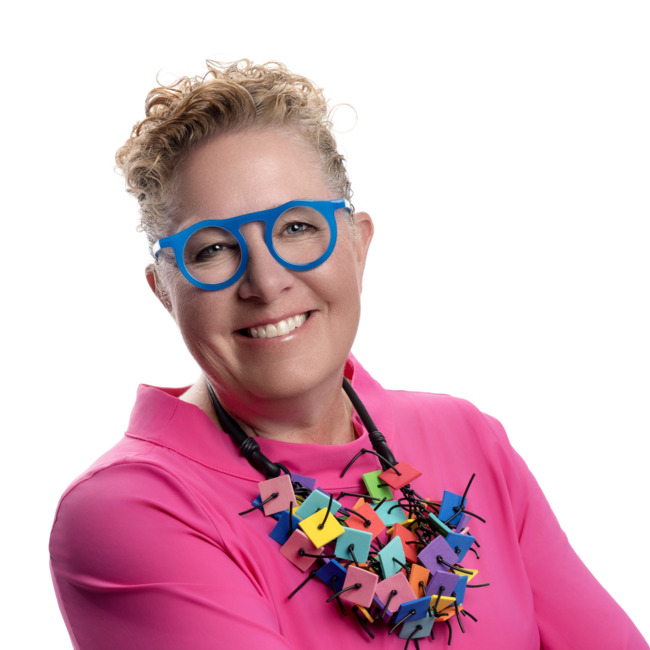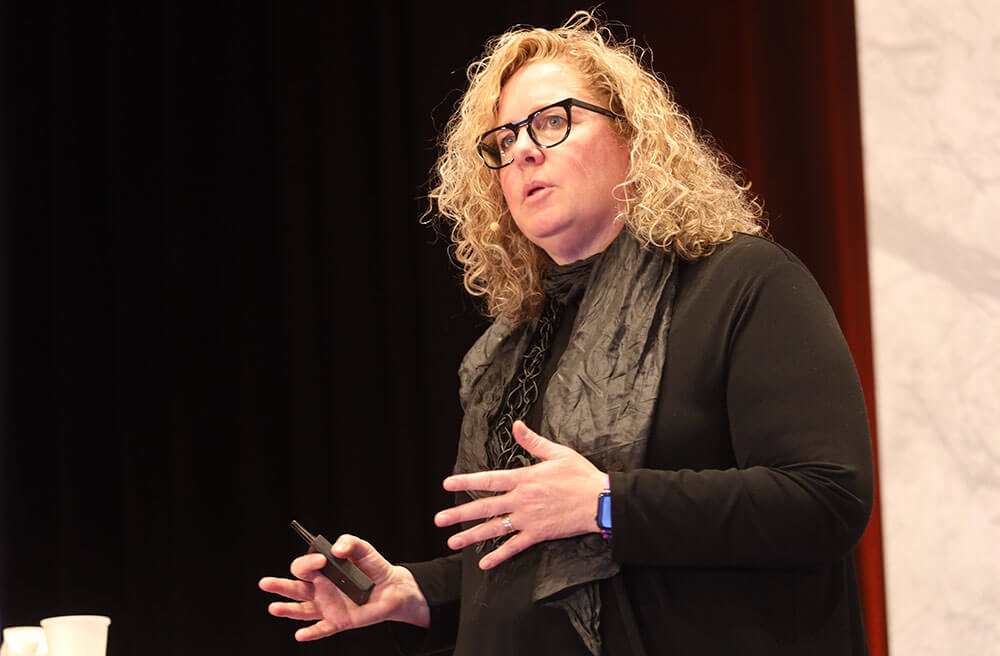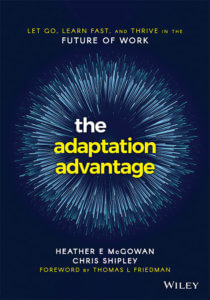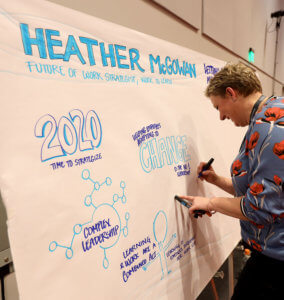Future-Proofing Your Career

Author: Barbara Palmer

“If you’re not learning every day, your job is moving away from you,” future-of-work strategist Heather McGowan told Convening Leaders attendees in January. (Jacob Slaton Photography)
It may feel as if work already has been changing at breakneck speed, but when it comes to the pace of disruptions ahead, “buckle up,” advises future-of-work strategist Heather McGowan.
“We’re going from a world that was complicated, where problems broke down into sub-components, to a world that’s complex,” McGowan told an audience at Convening Leaders in January in San Francisco, where she presented the session “Letting Go and Learning Fast to Thrive.”
And, just as we’re going through the greatest velocity of change in human history, we’re making the greatest leaps in longevity — “which means we have to move through more change cycles,” said McGowan, a professor at the Centre for the New Workforce at the Swinburne University of Technology, in Melbourne, Australia. During the first industrial revolution, when the steam engine was invented, life expectancy was 37 years. Workers had two-and-a-half generations to absorb that paradigm-shifting change, McGowan said. “Now you’re going to have to absorb two, three, four, five paradigm shifts within a single generation. We’re not prepared for that. We’re not talking about that. Everyone’s No. 1 job now is to help people adapt to change.”
In the past, “we learned once in order to work,” McGowan said, “and in the future — which is really now — learning and work will be combined.” Success in our increasingly automated world will also depend on the uniquely human skills that make us better at our jobs, “things like creativity, collaboration, and communication, which are not the things you’re generally hired for,” said McGowan, co-author of upcoming book, The Adaptation Advantage: Let Go, Learn Fast, and Thrive in the Future of Work. “We’ve left our human skills behind. It’s time to bring them back.”
McGowan talked about the future of work with Convene via email.
Why do we need to rethink work and learning?
Our systems of learning are built for transferring existing knowledge and skills. Our systems of work are designed to screen candidates for known skills to do known jobs with some level of certainty. It’s helpful to understand our transition from the third industrial revolution to put into context why we need to rethink both our systems of learning, particularly as it relates to workforce preparation, and our methods of recruiting and screening talent for the workforce.

The Adaptation Advantage: Let Go, Learn Fast, and Thrive in the Future of Work is set for a Spring 2020 release.
The first industrial revolution was powered by steam, the second by electricity, the third by computerization. The fourth is marked by the merging of physical, biological, and cyber systems where mentally routine and predictable tasks — this is a large part of our knowledge work — can be achieved by an algorithm.
Our mental models are stuck in the third industrial revolution where we learned only once in order to work. The knowledge and skills needed by the workforce could be codified into a curriculum and transferred into a new set of humans to create a deployable workforce. But now the change rate is too fast: We cannot codify and transfer skills fast enough, especially technical skills, which expire faster than the time it takes to get a degree.
On the work side, we need to rethink recruitment and hiring processes for so many reasons. The timeframe of a search process is often eclipsed by the change rate. Once a need is identified, the budget approved to add a person, the search process is conducted, and the candidates selected and onboarded, the original need has changed.
Further, all the research suggests that greater gender, racial, cultural, age, and cognitive diversity creates better and stronger teams more adept at accelerated learning with greater financial returns. Yet our hiring systems are not built for attracting diversity — they are built for screening for set credentials and signals.
What are the key things that are most helpful for people to understand about successfully adapting to radical change?
The velocity of change is accelerating at the same time our careers are expanding, due to leaps in human longevity. This means we need to be prepared to have multiple careers and, with that, multiple occupational identities. In order to learn and adapt through these roles and identities, you need to have a certain level of comfort with ambiguity, change, and failure. You cannot learn if you already know.
I have a mental model of an iceberg that I share in my talks. In order to get to this level of comfort with change, you need to build out the entire ice- berg, not just the piece that is sticking out of the top — the explicit skills or what you are hired to do.
I believe the iceberg has four layers: At the bottom is a resilient and adaptive identity. Studies have shown that job loss can take twice as long to recover from as the loss of a primary relationship, because we have become fixed to a single occupational identity. Here we need to move from identities bestowed by a third party — employer, alumni association, trade union, or company brand — to an internally validated self-actualized identity.
The next layer up is an agile learning mindset. This is the ability to learn and adapt with agency, adaptability, agility, and awareness. The next layer up from that at the water line is what I call “the enablers” or the uniquely human skills — often called soft skills, these are skills that make us better at our jobs and indeed in all of our relation- ships. The enablers are at the water line because they are sometimes visible and evident. At the top and out of the water are the explicit skills for which we are hired. We have to think about these skills the way we think about applications on our phone: We will add and delete them as needed for the rest of our lives.
You speak and write about the concept of agile learning. What is the difference between speed and agility?
Speed is how fast you are going while agility is how quickly you can change direction. My concept for the agile learning mindset focuses on that ability to change direction, which I think is more difficult than simply going faster in the same direction. Changing direction often involves letting go of old methods, unlearning, and relinquishing your occupational identity and your position as an expert.
Related: The Agile Learning Mindset
You’ve identified vulnerability, creativity, and empathy as essential skills. Can you talk about the role that they play in the future of work? Creativity, empathy, and vulnerability are hard to automate — they simply do not lend themselves to codification. Beyond that, and more importantly, these are the skills of modern leadership. If you take your existing work and strip away anything mentally routine or predictable, what is left is work that is in the volatile, uncertain, complex, and ambiguous (VUCA) realm.

A graphic recorder illustrates Heather McGowan’s Convening Leaders session, “Letting Go and Learning Fast to Thrive.” (Jacob Slaton Photography)
This is work for which we need agile teams learning together. Leadership here is not about driving productivity or efficiency, it is about inspiring human potential and leading teams of humans into the unknown, into discovery. In order to do this, a leader must be vulnerable to both establish trust with the team but also to model the behavior of being comfortable not knowing, comfortable being wrong, comfortable failing or making errors and learning from them. If the leader pretends to know answers that she does not or masks a gap in skills or knowledge, she signals to her team to follow her example and then you end up with a compromised team full of weaknesses. So, a leader who cannot show vulnerability creates team weakness. Doing things that have never been done before requires creativity. Or as Dr. Brené Brown says, “Vulnerability is the birthplace of innovation, creativity, and change.”
Is there a better term for those kinds of skills than soft skills?
I prefer “uniquely human skills” or “enablers” as they are what enable you to be better at your job or better at your relationships.
You have said that you are an optimist about the future of work. What are some of the things that give you hope?
Humans are incredibly adaptive. We have made regions habitable that were inhabitable to our ancestors. In the past, 100 percent of us worked
in agriculture — back then, it was just called “survival.” Now, less than 2 percent of us work in farming, yet we have more food.
In the last 65 years, we have moved more people out of extreme global poverty, made more people literate, and for the past 25 years or so that we have had this thing called the internet, we have connected more than half the world’s population. I do worry about income inequality and I am concerned about the most vulnerable among us, but I remain optimistic about our ability to adapt and continue to improve the human condition for all.
Go to Heather McGowan’s website for more information.
Barbara Palmer is deputy editor at Convene.









